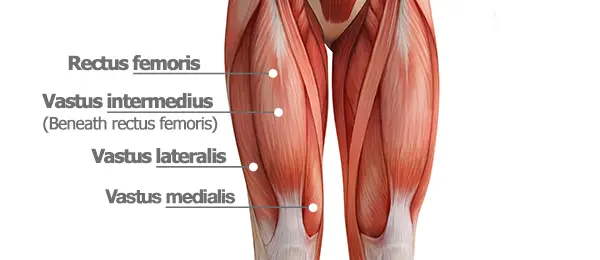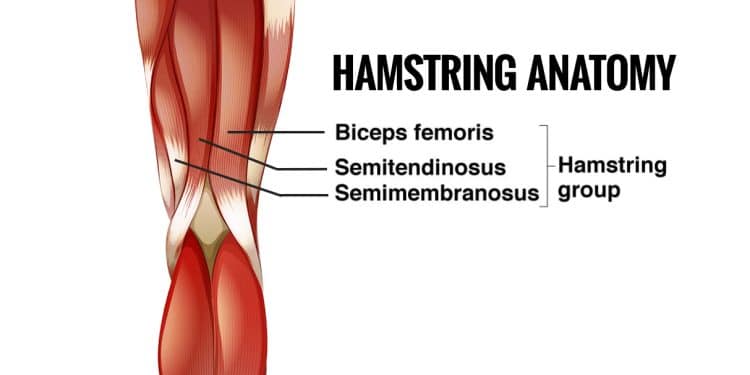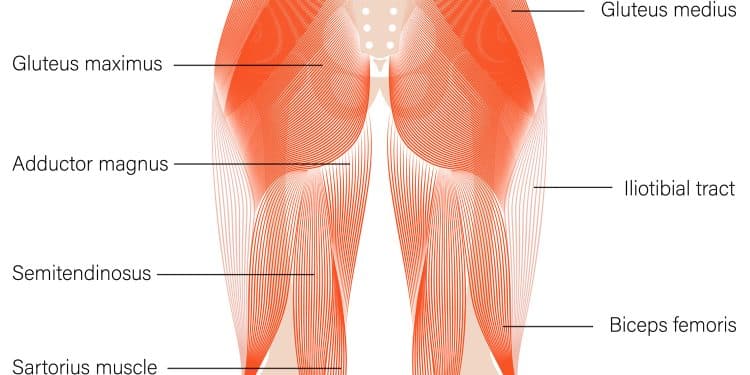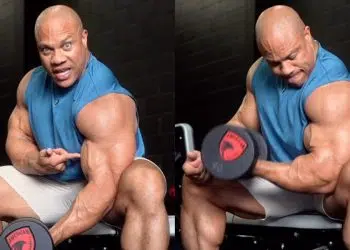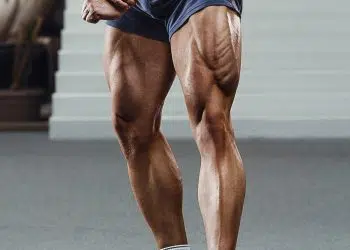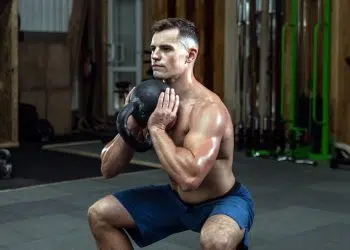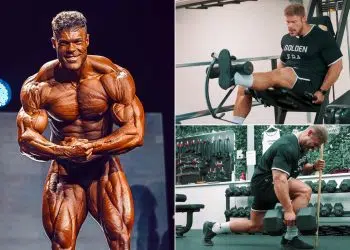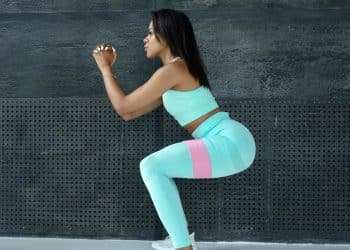I’m a NFPT-certified fitness trainer, so it’s my job (and pleasure!) to help people lose weight, get fit, and build muscle. I take pride in providing my clients with the best possible exercises and workouts for their needs and goals. After all, their success is also my success.
In this mission, my main “weapon of choice” is dumbbells, as this versatile training equipment can be used to train one or both sides of your body at once — the result: better coordination, joint stability, muscle stimulation, and correction of muscle imbalances.
Dumbbells are also ideal for home workouts, as they’re small, easy to store, and readily available. In short, there’s nothing ‘dumb’ about dumbbells!
Dumbbells are also ideal for home workouts, as they’re small, easy to store, and readily available. In short, there ain’t nothing dumb about dumbbells! In this article, I reveal the 12 best dumbbell leg exercises and share two of my favorite dumbbell leg workouts.
Recent Updates: On May 22, 2024, Fitness Volt’s Senior Editor Vidur Saini revised the list of exercises and added expert tips throughout the article. We also updated this article to improve readability. Level Up Your Fitness: Join our 💪 strong community in Fitness Volt Newsletter. Get daily inspiration, expert-backed workouts, nutrition tips, the latest in strength sports, and the support you need to reach your goals. Subscribe for free!
12 Best Dumbbell Leg Exercises
Train your quads, hamstrings, glutes, and calves with these amazing dumbbell leg exercises:
- Dumbbell Squats
- Dumbbell Sumo Squats
- Goblet Squats
- Dumbbell Jump Squat
- Dumbbell Thruster
- Dumbbell Walking Lunges
- Dumbbell Reverse Lunge
- Dumbbell Step-Ups
- Bulgarian Split Squat
- Dumbbell Romanian Deadlift
- Standing Calf Raise
- Dumbbell Seated Calf Raise
1. Dumbbell Squats
| Sets & Reps | 3 x 8-12 for hypertrophy, 1-5 for strength |
| Equipment Needed | Dumbbells |
| Target Muscles | Quadriceps and gluteus maximus, hamstrings, and calves |
Squats are hands down, one of the most effective leg exercises you can do. While most people gravitate toward barbell back squats, dumbbell squats are just as effective. In my opinion, they provide a more comfortable, accessible workout — especially for beginners.
“While performing dumbbell squats, hold the dumbbells in a position that feels the most comfortable to you and compliments your biomechanics,” says Saini, an ACE-certified personal trainer. “You could hold them at your sides or in front of your shoulders.”
How To:
- Grab a pair of dumbbells using a neutral grip at your sides and stand up straight.
- Position your legs shoulder-width apart with toes slightly pointed out.
- Inhale the movement by bending your knees while keeping your core tight and spine straight.
- Continue to go down until your thighs are at least parallel to the floor.
- Drive through your heels to return to the starting position.
- This completes your first repetition, repeat for eight to 10 reps.
Pro Tip: People with mobility issues could elevate their heels using a squat wedge or placing them on weight plates.
Benefits:
- It’s a compound movement that trains and strengthens the complete lower body.
- Engages the core but does not stress the lower back.
Variations
- Progression: Goblet squat
- Regression: Bodyweight squat
2. Dumbbell Sumo Squats
| Sets & Reps | 3 x 8-12 for hypertrophy, 1-5 for strength |
| Equipment Needed | Dumbbells |
| Target Muscles | Adductors, glutes, quads, hamstrings, calves, hip flexors, and core muscles |
Sumo squats involve a wide stance. This increases adductor (inner thigh) and glute engagement. In addition, sumo squats will help improve your hip mobility and flexibility. This is a popular exercise with athletes trying to grow their glutes.
How To:
- Grab a dumbbell with both hands in front of your hips. You can grab the dumbbell by its handle or plate.
- Position your feet a little wider than the shoulder’s width with your toes pointing outward.
- Lower into a squat by bending your knees and leaning forward slightly.
- Go as low as your mobility allows.
- Pause for two seconds at the bottom before you push yourself up.
- Repeat for 8-10 reps.
Pro Tip: Try a 4-3-1-1 tempo, which means four seconds on the eccentric phase, three seconds hold at the bottom, and one on the concentrics and at the top.
Benefits:
- Increased leg range of motion.
- Improved blood circulation to your groin area.
- Reduced tension in your hip joints.
- Greater flexibility.
- Less risk of muscle tears or strains.
Variations
- Progression: Goblet sumo squat
- Regression: Bodyweight goblet squat
3. Goblet Squats
| Sets & Reps | 3 x 8-12 for hypertrophy, 1-5 for strength |
| Equipment Needed | Dumbbells |
| Target Muscles | Adductors, glutes, quads, hamstrings, calves, hip flexors, core muscles |
Goblet squats work the same leg muscles as the conventional dumbbell squats, but because the load is at your chest level, it requires significant core engagement. You must keep your core braced to maintain an upright torso throughout the exercise.
How To:
- Stand with your feet shoulder-width apart and toes pointing slightly outward.
- Grab a single dumbbell and hold it with both hands.
- Flex your elbows to position the dumbbell in front of your mid-chest.
- Inhale and flex your knees to lower yourself into a squat.
- Get down until your thighs get parallel to the ground.
- Exhale and push yourself back to the starting position.
- Repeat for recommended reps.
Pro Tip: Push your knees outward during the descent to achieve a greater depth.
Benefits:
- Goblet squats allow a greater range of motion.
- Improves hip mobility while strengthening the inner thighs.
- Develop stronger glutes while making your core work harder.
Variations
- Progression: Front rack dumbbell squat
- Regression: Bodyweight squat
4. Dumbbell Jump Squat
| Sets & Reps | 3 x 8-10 |
| Equipment Needed | Dumbbells |
| Target Muscles | Quads, glutes, hamstrings, calves, core |
Dumbbell jump squats can be an incredibly effective tool for developing lower body strength and explosiveness, says Saini. A major part of your quads comprises fast-twitch muscle fibers. Jump squats train those fast-twitch muscles to improve the strength and size of your legs.
This exercise should be avoided by people dealing with lower body joint issues.
How To:
- Grab a pair of dumbbells with your feet shoulder-width apart.
- Extend your arms at your side.
- Keep your torso engaged and your back straight.
- Inhale and squat down until your thighs are parallel to the ground.
- Exhale and push through your heels to jump upwards while keeping your arms extended at your side.
- Land on the balls of your feet. This completes one repetition.
- Perform the recommended reps.
Pro Tip: Use your hands to generate more power and momentum.
Benefits:
- Develops explosive power.
- Trains the fast-twitch muscle fibers that are responsible for strength and size.
Variations
- Progression: Box jumps
- Regression: Dumbbell squat
5. Dumbbell Thruster
| Sets & Reps | 3 x 8-12 for hypertrophy, 1-5 for strength |
| Equipment Needed | Dumbbells |
| Target Muscles | Quads, glutes, hamstrings, calves, shoulders, triceps, core |
It is a movement used widely by CrossFit athletes that combines dumbbell squats and shoulder presses. Dumbbell thrusters can help build full-body strength and conditioning, but your legs are the engine during this intense movement.
How To:
- Stand with your feet slightly wider than the hip-width apart while holding onto a pair of dumbbells.
- Brace your core and Clean the dumbbells up to your shoulders so they are touching your shoulder.
- Keep your elbows pointing forward. Now this will be your starting position.
- Inhale as you bend your knees to lower into a squat until your thighs are parallel to the ground.
- Explode up by extending your hips, knees, and ankles while pushing the dumbbell overhead.
- Perform the recommended reps.
Pro Tip: Use the leg drive to push the dumbbell overhead. And as you do the overhead movement, keep the arms close to your ears, and parallel to each other.
Benefits:
- A full-body push movement.
- Helps build explosiveness.
- It’s a perfect full-body exercise for days when you have limited time for training.
Variations
- Progression: Dumbbell snatch
- Regression: Dumbbell squats
6. Dumbbell Walking Lunges
| Sets & Reps | 3 x 8-12 for hypertrophy |
| Equipment Needed | Dumbbells |
| Target Muscles | Quadriceps, glutes, hamstrings, calves, abdominals, hips |
Dumbbell walking lunges engage the hip stabilizer muscles and strengthen your core. It can also help improve your overall conditioning and boost fat-burning. Seriously; what’s NOT to love about dumbbell walking lunges?
“Step out slightly to the sides while performing walking lunges for added stability,” recommends Saini. “This will also promote adductor stimulation.
How To:
- Hold the dumbbell using a neutral grip with your chest up and spine straight.
- Step forward with your right leg.
- Lower your body until the right thigh is parallel to the ground.
- Transfer your body weight to the right leg as you return to the starting position.
- Now step forward with your left leg and alternate between legs for recommended reps.
Pro Tip: Smaller steps lead to greater quad engagement, whereas longer strides shift the bias to the hamstrings and glutes.
Benefits:
- This unilateral movement promote muscle and strength balance.
- It also improves hip mobility and core stability.
- Helps you develop bulletproof knees.
- It’s a functional exercise that increases longevity and will make your day-to-day task easier.
- Walking lunges strengthen your glutes. A 2020 study suggests that walking lunges offers better glute activation than conventional squats. [1].
Variations
- Progression: Plyo lunges
- Regression: Split squats
7. Dumbbell Reverse Lunge
| Sets & Reps | 3 x 8-12 for hypertrophy, 1-5 for strength |
| Equipment Needed | Dumbbells |
| Target Muscles | Glutes, hamstrings, quads, calves |
Reverse lunges are more glute and hamstring-centric than forward lunges. Additionally, they also tend to be more knee-friendly. It’s much easier to keep your front shin vertical during reverse lunges, and this is one of my preferred lunging variations for beginners and clients.
How To:
- Hold the dumbbell with a neutral grip at your sides.
- Step back with your right leg.
- Lower your body until the left thigh is parallel to the ground.
- Keep your chest proud throughout the ROM.
- Drive your left heel into the ground and extend your knee to return to the starting position.
- Now step backward with your left leg.
- Alternate between sides for the recommended reps.
Pro Tip: Avoid using your rear leg to push yourself out of the bottom position. The rear leg only plays a supporting role.
Benefits:
- Reverse lunges activate and strengthen your glute, quad, and hamstrings.
- It’s relatively easier on knee joints than the forward walking lunge.
- It’s another unilateral movement that improves the whole body’s stability and balance.
Variations
- Progression: Walking backward lunges
- Regression: Split squats
8. Dumbbell Step-Ups
| Sets & Reps | 3 x 8-12 for hypertrophy, 1-5 for strength |
| Equipment Needed | Dumbbells, plyo box |
| Target Muscles | Quads, glutes, adductors, hip flexors, hamstrings, calves, core |
Step-ups are a versatile exercise that not only enhances your everyday movements but also boosts athletic performance. The higher the step, the more challenging this exercise becomes, so they’re also very scalable and suitable for all fitness levels.
How To:
- Stand in front of a bench or stepper and grab a pair of dumbbells using a neutral grip.
- Place your right foot on the stepper while the left is grounded.
- Extend your right knee to lift yourself off the ground.
- Position your left foot alongside the right.
- Slowly lower yourself to get into the starting position.
Pro Tip: Avoid dropping to the floor. Use slow eccentrics to increase the time under tension (TUT) and promote hypertrophy.
Benefits:
- Develop toned and functional legs.
- It will increase your squatting and deadlift strength.
- Excellent leg exercise for someone with back pain.
- You can increase or decrease the intensity by changing the platform height.
Variations
- Progression: Box jumps
- Regression: Forward lunges
9. Bulgarian Split Squat
| Sets & Reps | 3 x 8-12 for hypertrophy, 1-5 for strength |
| Equipment Needed | Dumbbells, flat bench |
| Target Muscles | Quads, glutes, hamstrings, calves, core |
The Bulgarian split squat is an incredibly challenging exercise. However, it can also improve hip mobility and balance. Saini recommends beginners start with a lower elevated surface, as it can limit the range of motion and lead to improved balance.
How To:
- Grab a pair of dumbbells in both hands.
- Begin with your left foot on the ground and your right foot on a bench behind you.
- Keep your chest up and your torso braced.
- Inhale and bend your knees to lower yourself until your left thigh is parallel to the ground.
- Exhale and push yourself back up.
- Repeat for recommended reps before switching sides.
Pro Tip: Grab a dumbbell in one hand and hold a study object for balance with the other.
Benefits:
- Focuses on unilateral leg development while improving balance.
- The feet elevated setup maximized quad and glute stimulation.
Variations
- Progression: Barbell Bulgarian split squat
- Regression: Split squat
10. Dumbbell Romanian Deadlift
| Sets & Reps | 3 x 8-12 for hypertrophy, 1-5 for strength |
| Equipment Needed | Dumbbells |
| Target Muscles | Erector spinae, gluteus maximus, hamstrings, adductors, calves, arms, core |
The Romanian deadlift is an excellent compound movement that trains the whole posterior chain. You must master the dumbbell Romanian deadlift (RDL) movement mechanics before trying to lift heavy.
How To:
- Plant your feet hip-width apart and hold a pair of dumbbells against your thighs with an overhand grip.
- Keep your chest proud and scapula retracted.
- Hinge at the hips to lower your upper body toward the floor while pushing your glutes back.
- Exhale and pull yourself up to the starting position.
- Repeat for recommended reps.
Level Up Your Fitness: Join our 💪 strong community in Fitness Volt Newsletter. Get daily inspiration, expert-backed workouts, nutrition tips, the latest in strength sports, and the support you need to reach your goals. Subscribe for free!
Pro Tip: Maximize glute and hamstring development by slowing down eccentric motion and pausing in the bottom position.
Benefits:
- It enhances the performance of the lower back, hip, and hamstrings.
- It’s a compound movement that helps build strength.
- Improves your ability to deadlift or squat.
Variations
- Progression: Single-leg dumbbell RDL
- Regression: Seated hamstring curl
11. Standing Calf Raise
| Sets & Reps | 3 x 8-12 for hypertrophy, 1-5 for strength |
| Equipment Needed | Dumbbells |
| Target Muscles | Gastrocnemius |
The standing calf raise is one of the best exercises to target your calves. Calves stabilize your lower body joints and reduce the risk of injuries.
How To:
- Hold a dumbbell in each hand and stand with a hip-width stance.
- Keep your arms extended on your sides.
- Rise up onto your toes, and squeeze your calves for two seconds before slowly returning to the starting position.
- Repeat for recommended reps.
Pro Tip: Perform this exercise on an aerobic stepper to achieve a deep calf fiber stretch at the bottom and promote hypertrophy.
Benefits:
- Develop calf strength, endurance, and explosiveness.
- Improves ankle stability.
Variations
- Progression: Single-leg calf raises
- Regression: Seated calf raises
12. Dumbbell Seated Calf Raise
| Sets & Reps | 3 x 8-12 for hypertrophy, 1-5 for strength |
| Equipment Needed | Dumbbells, aerobic stepper, flat bench |
| Target Muscles | Soleus |
Exercises that involve fully extended knees, like the standing calf raise, bias the gastrocnemius muscle, whereas bent-knee movements, such as the seated calf raises, load the soleus muscle, explains Saini.
Seated calf raise primarily trains the soleus, the muscle beneath the gastroc. Incorporating this exercise into your routine can help build bigger and thicker lower legs.
How To:
- Sit down on a bench or any other stable elevated surface.
- Place a stepper or thick weight plate in front of your bench to place the balls of your feet on.
- Get a set of moderate-weight dumbbells and place them vertically on your thighs just above your knee.
- Now push through the balls of your feet to feel the contraction in your calves.
- Lower your heels as far as you can for a deep stretch.
- Repeat for recommended reps.
Pro Tip: Perform unilateral seated calf raises to develop a deeper calf mind-muscle connection.
Benefits:
- Seated calf raises will help develop calf thickness.
- Stronger calves boost your running and jumping performance.
- Develop a resilient ankle.
Variations
- Progression: Dumbbell farmer’s walk on toes
- Regression: Bodyweight standing calf raises
Dumbbell-Only Legs Workout Plan
Barbell squats are undeniably the best way to add strength and size to the legs, but that doesn’t mean you can’t develop stronger legs without a barbell. A dumbbell-only leg routine is enough to build a stronger foundation and beach-ready body.
Give below are two dumbbell leg workouts. Now you might ask, why two workouts? Two workouts are best for folks who like to train their legs twice a week; it will prevent redundancy in training.
Dumbbell Legs Workout #1
| # | Exercise | Sets | Reps | Recovery |
| 1 | Dumbbell Squat | 4 | 8-10 | 1-2 Minutes |
| 2 | Dumbbell Front Squat | 3 | 10-12 | 60-90 Seconds |
| 3 | Reverse Lunge | 3 | 12-15 | 60 Seconds |
| 4 | Dumbbell Elevated Split Squat | 3 | 8-10 | 60 Seconds |
| 5 | Dumbbell Romanian Deadlift | 4 | 8-12 | 90 Seconds |
| 6 | Dumbbell Hip Lift March | 3 | 12 | 60 Seconds |
| 7 | Dumbbell Seated Calf Raise | 4 | 12 | 30 Seconds |
Dumbbell Legs Workout #2
| # | Exercise | Sets | Reps | Recovery |
| 1 | Dumbbell Goblet Squat | 4 | 10-12 | 1-2 Minutes |
| 2 | Bulgarian Split Squat | 3 | 10-12 | 60 Seconds |
| 3 | Dumbbell Step-Up | 3 | 12-15 | 60 Seconds |
| 4 | Dumbbell Around the World Lunge | 3 | 8-10 | 60 Seconds |
| 5 | Single-Leg Romanian Deadlift | 4 | 8-12 | 60 Seconds |
| 6 | Dumbbell Hip Thrust | 3 | 12 | 60 Seconds |
| 7 | Standing Calf Raise | 4 | 12 | 30 Seconds |
More Leg Workouts:
- How to Get Bigger Thighs
- Ronnie Coleman’s Leg Workout
- Three Killer Leg Workouts
- At-Home Leg Workouts
- Best Quadriceps Exercises
- Best Old-School Leg Workouts
- Simple Old-School Way To Grow Your Legs
- Front Squat Hypertrophy Guide
- Ronnie Coleman’s Quad Workout
Legs Anatomy
While you don’t need a degree in muscle anatomy and physiology to build strong, capable, great-looking legs, a little knowledge can be helpful. For example, knowing your glutes from your quads will make it easier to choose the best exercises for your needs and goals. To that end, here is an overview of the muscles that make up your marvelous lower body.
Quadriceps:
The front part of the upper leg is called the quadricep (quad). Its primary function is knee extension. Quads comprise four muscle fibers: vastus lateralis, vastus medialis, vastus intermedius, and rectus femoris.
Vastus lateralis is the biggest quad muscle; it comprises about 69 percent fast-twitch fibers and about 32 percent slow-twitch fibers, meaning your quad will respond more to high-intensity or high-strength exercises.
Hamstrings:
Hamstrings are located at the back of your upper legs, and knee flexion is their primary function. The hamstrings comprise four muscles: the long head of the biceps femoris, the short head of the biceps femoris, the semitendinosus, and the semimembranosus..
Glutes:
Technically, the glutes are not a part of the legs, but they play a major role in the quality of your leg workout. Glutes comprise of three muscles gluteus maximus, gluteus medius, and gluteus minimus.
Strong glutes are essential for proper pelvic alignment, and they also support the lower back during training. With weak glutes, you will never be able to maximize your squatting performance.
The glutes work as a primary stabilizer, and all three glute muscles are strengthened while squatting. However, it is always a good idea to include some glute-focused workouts like single-leg glute bridges, sumo deadlifts, and single-leg RDLs, in your workout.
Calves:
Big and strong calves are for more than just good looks; calves play a critical role in ankle, foot, and toe movement. Calves consist of two main muscles — the gastrocnemius and soleus.
The ratio of fast-twitch and slow-twitch muscle fibers in your calves is 50:50. Meaning, you should train calves equally at a higher and lower intensity.
Dumbbell Leg Training Benefits
Dumbbell leg training has unique benefits. Let’s have a look at some practical benefits that dumbbells provide:
1. Joint-Friendly Training
Dumbbell squats are a joint-friendly alternative for people who experience back or hip pain. They allow you to work around your injuries during the muscle rehabilitation process.
2. Great For Unilateral Training
Unilateral training gets more critical when training a complex body part.
You can perform a wide range of unilateral activities with the help of dumbbells. You can do forward lunges, reverse lunges, Bulgarian split squats, single-leg stiff-legged deadlifts, single-leg step up, and many other exercises.
The significant benefit of unilateral training is it equally trains both sides to rectify asymmetries and imbalances.
3. Dumbbells Are Easier To Train With
Beginners are often uneasy about squatting down with a barbell on their backs. A dumbbell is definitely a safer and more convenient option for many exercises.
Additionally, you don’t need to worry about having a spotter. You can just drop the dumbbells if you are about to fail a rep.
4. Dumbbells Are Easily Available
Unlike squat racks, dumbbells are usually available during gym rush hours.
Dumbbells are also an excellent tool for someone who wants to work out at home but does not have the budget to invest in a squat rack or barbells.
Frequently Asked Questions
Is it okay to work out legs every day?
If you want fast results, we suggest you focus more on nutrition and recovery; training your legs daily is not going to grow them faster. Instead, it will increase the chances of muscle overuse injuries.
A few sets of bodyweight squats or lunges can be done daily, but you shouldn’t do heavy-weight leg training everyday.
Do legs respond better to higher reps?
It has been known that heavy weight and low reps help increase strength, and lightweight and high reps increase endurance.
Higher reps activate slow-twitch muscle fibers that are responsible for greater endurance. Higher reps also keep the joints healthy and muscles toned.
If you are someone who does not have access to weights, then doing a few reps of bodyweight squats and lunges sounds like a good idea to stay in shape. You can also choose exercises that are difficult with just bodyweight, for example: skater squat, single-leg squat, etc.
Can I target all leg muscles with dumbbell exercises in a single day?
Yes, of course. We have designed a dumbbell-only leg program that will target the quads, hamstrings, glutes, and calves. You can find those workout plans above.
How to warm up for a dumbbell leg workout?
Your warmup routine should wake up and activate all the target and supporting muscle groups. Here is a list of exercises you should do as a warmup.
- Jumping jack: To wake up your legs.
- Bodyweight jump squats: They will activate fast-twitch muscle fibers.
- Good Morning: Will activate the whole posterior chain for the workout.
- Single leg RDL: To activate the hamstrings and glutes for the workout. Do it with bodyweight or lightweight.
- Bodyweight side lunges: To open up hips and activate the inner portion of thighs.
How can I tone my legs with dumbbells?
If you want to keep your legs strong but toned, then focus more on high reps unilateral movements (ex: walking lunges) and plyometric movements (ex: jump squats).
Keeping the leg muscle non-bulky can be done by optimizing nutrition. Do not eat more than your daily calorie needs, and eat plenty of lean protein to maintain aesthetic legs.
Do I always have to hold the dumbbells down by my sides?
While most dumbbell leg exercises are prescribed with the weights by your sides, there are other positions you can use for your workouts. In some cases, the position of the dumbbells will emphasize certain muscles, while in others, it’s more a case of comfort or personal preference. Your main options are:
- Two dumbbells by your side: A low center of gravity, which is good for maximizing balance and stability.
- A single dumbbell by your side: Increases lateral loading, increasing core engagement and more challenging for you to balance.
- Dumbbells in the front rack position: This is where the dumbbells are held on your shoulders. The higher center of gravity means this position increases core engagement. You’ll also need to stabilize your upper back.
- A single dumbbell between your legs: Good for wide-stance exercises and for working your glutes and hamstrings more.
- A single dumbbell in front of your chest: It increases upper body engagement and is good for improving posture.
I suggest you experiment with these positions to determine which options work and feel best.
Need more information about dumbbell leg training? Drop me a line below and I’ll get back to you ASAP!
Wrapping Up
Using dumbbells for your leg workouts lowers the load placement, reducing the strain on your lower back while enabling you to target the leg muscles effectively. It’s also a great alternative to working out at home if you don’t have barbells, squat racks, and other equipment.
With the movements above, you can train all the critical leg muscles — quads, hamstrings, glutes, hips, and calves — for a better, stronger, more mobile lower body!
References:
- Neto W K, Soares E G, Vieira T L, Aguiar R, Chola T A, Sampaio VD L, and Gama E F. Gluteus Maximus Activation during Common Strength and Hypertrophy Exercises: A Systematic Review. J Sports Sci Med. 2020 Mar; 19(1): 195–203. 2020 Feb 24. PMID: 32132843
Article Updates Timeline:
Our editorial team experts constantly update the articles with new information & research, ensuring you always have access to the latest and most reliable information.
December 23, 2023
Updated By
Patrick Dale, PT, ex-Marine
December 6, 2023
Updated By
Andrew Peloquin NFPT-CPT
January 29, 2023
Updated By
Tom Miller, CSCS
October 15, 2021
Written By
Andrew Peloquin NFPT-CPT

